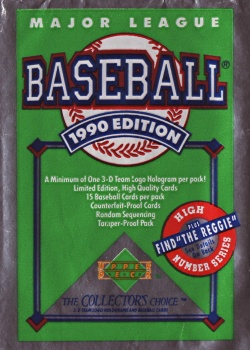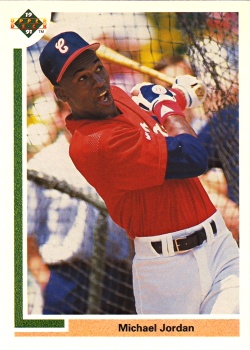The 1990s, decade of despair
This is the middle act in a three-part series documenting my 20+ year on-again/off-again relationship as a procurer of cardboard rectangles from The Upper Deck Company, LLC. When we left off in Upper Deck: A Love Story (Part 1), a chance encounter brought Upper Deck into my life just as the card collecting hobby went mainstream in a big way. Now our relationship would be put to the test.
By 1990, card shops were fading and card shows were the new fad. Collectors would pack malls, event halls, or any available open space in the hopes of scoring the next big thing. The hobby was in full swing and I was finally invited to the party; it was a great time to collect cards.
At the time, I was heavily invested in Donruss, working on a set that somehow never got finished. While this was the first product that I had opened an entire box of (my entire life up to this point had been pack-to-pack), my brother had graduated to breaking cases with a massive purchase of 1990 Topps, a set that I would soon grow to despise after long hours tearing through wax to build sets and pull cards of young stars Ken Griffey Jr. and Frank Thomas.

That summer, I once more found myself in possession of packs of Upper Deck, this time 1990 Upper Deck High Number Edition. The price of the 1989 product, which was now finally available locally, was far above what I could afford, but the current product was still within reach. And so, recalling my experience from the previous year, I once more dove in to sample the newcomer’s latest offering.
This time around, the design elements were limited to just a strip along the top representing the basepath from first to second, a rather dull continuation of the theme started by 1989’s first base path. The quality remained the same, but it wasn’t new and exciting anymore. Until I opened the pack that held a treasure unlike anything I had ever seen before.

In retrospect, that card wasn’t as special as it seemed at the time, but it was more significant to the history of the hobby than my big 1989 pull. This time, the card bore no name or number, just the words “Baseball Heroes” on the front and some text on the back about Reggie Jackson. What could it be? In the thrill of the moment, I scrutinized the back of the pack for any clues to the identity of the wondrous gem I had unwrapped. For a moment, I thought that just maybe this could be the rare find mentioned in the odds listing, but that card was supposed to be autographed – this one clearly was not. Instead, it seemed to be from the Reggie Jackson Baseball Heroes set, but why didn’t it have a number or a picture of Reggie Jackson? I was holding the first-ever Baseball Heroes header card and a new obsession had just begun.
The “Find the Reggie” Reggie Jackson Baseball Heroes set became known as the first commercially-successful insert set in the history of the hobby. While inserts of various kinds had existed for many years, none had surpassed the popularity of the base product. Upper Deck changed that in 1990 and started a mad rush to make, and pull, the next hot inserts. In just two years, Upper deck had transformed the hobby into something that closely resembles what we have today. This was the biggest change since the standardization on the 3.5″x2.5″ card size and I was right there in the middle of it.
Or at least I wanted to be. My heart was with Upper Deck, but my wallet took me in a different direction. The following year, I put my resources into 1991 Score, a massive set that, like 1990 Donruss before it, remains painfully incomplete. Pack after pack, I worked my way through stars, prospects, draft picks, highlights, and the extra special Dream Team inserts. Series 1 gave way to Series 2, as had become standard practice in many products that year. All the while, Upper Deck remained on the periphery, just a pleasant distraction and little more.
1991 was when Upper Deck fell behind in the pursuit of quality in baseball cards. That year, Topps and Fleer introduced high-quality glossy cards with full-bleed photographs in their Stadium Club and Ultra products, respectively. I barely noticed, unable to fund the purchase of such superior cards. The arms race was well underway.
Oh, how the hobby had changed by 1992. Premium lines were sprouting up everywhere and even Bowman and Donruss had gone premium. Triple Play (which makes an intriguing return this year) was introduced by Donruss to fill the gap in the low-end market, but it was a failure in every possible way (and how is it that, despite buying so much of it, I never came close to finishing that tiny set?). Upper Deck, finally done with the basepath motif after 1991’s design overdid it with the entire left half of the diamond, released what may be its most forgettable design. No longer the hot new product, Upper Deck dropped in value.

Three years ahead of its time
Which meant I could finally buy in big time! At last, I could afford to pick up boxes of 1991 and 1992 low and high number editions. Between the base set, the Baseball Heroes inserts, the occasional SP-numbered card, and those hologram stickers, I had plenty to work on. And plenty to get frustrated about when Upper Deck’s trademark collation problems became apparent. Still with us to this day, Upper Deck’s style of collation is guaranteed to get you lots of extra cards you don’t need and lots of missing cards no matter how many packs you buy. I desperately wanted to enjoy these products, but every box was like a slap in the face with double after double and little progress toward finishing a set. It didn’t take long to get disillusioned with the entire process.
Super premiums were introduced in 1993, cards seemingly designed to push me out of the hobby. While I could afford to sample a pack or two of each new hot product, there was no way to build a decent stock in any of them unless I focused on one to the exclusion of all others. In my misguided focus on quantity over quality, I kept buying up anything that was cheap. Upper Deck’s SP should have been my focus that year, but I bought two packs and moved on, drifting from product to product in search of something I never found.
Shock. Disbelief. Betrayal. This is what I felt when Upper Deck moved its mainline product up a tier to the new premium level in 1994. It had moved on to a new price class and I couldn’t follow. Worst of all, the Baseball Heroes insert set, which I had meticulously assembled in a set of binder pages over the previous four years, continued in the new premium format. All of my work came to a screeching halt.

Because "Collector's Last Refuge from Increasing Prices" was too cumbersome
As a consolation, Upper Deck introduced Collector’s Choice, which, like Triple Play before it, was a low-priced product aimed at kids without the resources to collect the “real” product. And so that’s where I focused my efforts, searching out Alex Rodriguez and Michael Jordan rookies and silver and gold signature cards. This was my life now, this was who I was. I could enjoy it or leave.
And then came 1995. While on the surface it appeared to be more of the same, there were major changes in the works. I resumed my efforts on Collector’s Choice, almost entirely ignoring regular Upper Deck and SP, but now there was a Collector’s Choice SE. Huh? I never understood the point of this blue-bordered clone of Collector’s Choice, but that didn’t stop me from buying it. Elsewhere, the hobby was getting more cluttered than ever, with six manufacturers all putting out multitudes of products and trying to find the next big innovation in card design, failing more often than not. I couldn’t take it anymore.
And so ends this chapter in my life with Upper Deck. I picked up a few packs in drug stores over the next summer and apparently a couple packs of whatever UD3 was in 1997, but those would be stashed away in random places and forgotten for several years. The hobby would undergo a metamorphosis in the meantime, but I had no patience for the ugly and messy early stages. If not for an improbable sequence of events, I might never have seen what would one day emerge from the chaos and uncertainty of the 1990s.
Next: Upper Deck: A Love Story (Part 3)
Comments are closed.